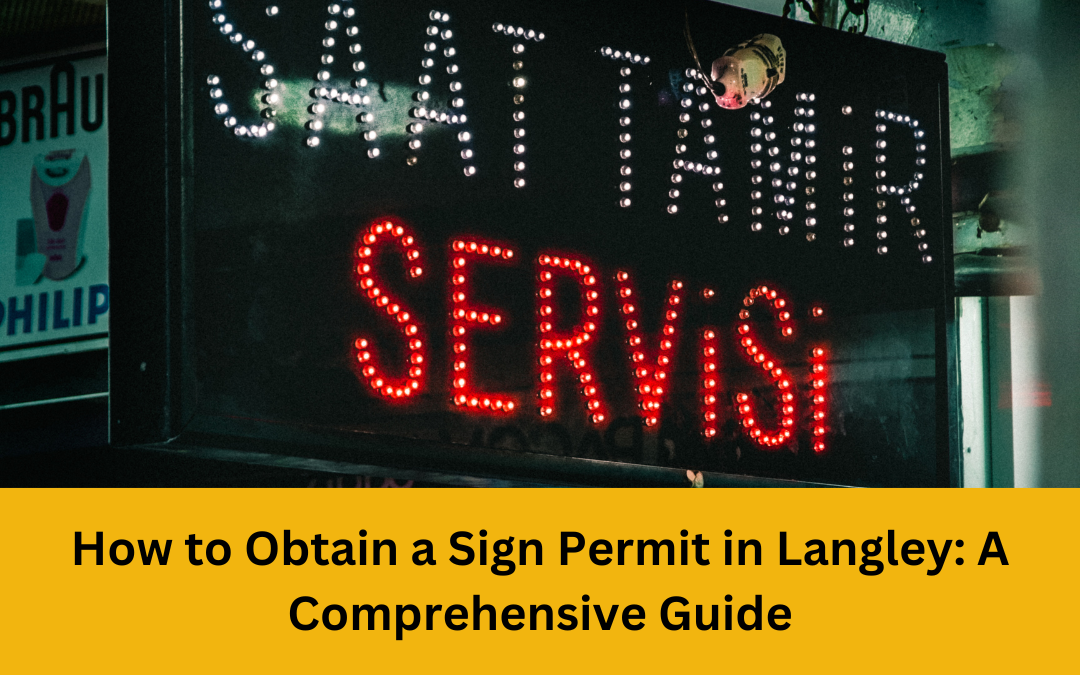Signage plays a crucial role in the success of businesses by attracting customers and conveying essential information. However, obtaining a sign permit is an important step to ensure compliance with local regulations and maintain the aesthetics and safety of the community. If you’re planning to install a sign in Langley, this guide will walk you through the process of obtaining a sign permit, ensuring a smooth and hassle-free experience.
Understanding Sign Permits:
a. Significance of Sign Permits: Before diving into the process, it’s essential to understand the importance of sign permits. Sign permits are required by local governments to regulate signage within their jurisdiction. They ensure that signs comply with safety, aesthetic, and zoning regulations, maintaining the overall visual appeal and safety of the community.
b. Langley’s Sign Permit Requirements: Langley has specific guidelines and regulations for sign permits, which vary depending on the location, type, and size of the sign. These requirements aim to balance the needs of businesses with the community’s overall aesthetics and safety.
Researching Local Sign Regulations:
a. Langley Municipality: Langley is divided into different zones, each with its own set of regulations regarding signage. Understanding the zoning regulations applicable to your business location is crucial before starting the sign permit application process.
b. Zoning and Land Use Regulations: Langley’s zoning regulations dictate the size, type, placement, and illumination of signs in each zone. Researching these regulations will help you determine what is allowed and what is not, ensuring compliance with the local requirements.
c. Sign Design Guidelines: Familiarize yourself with Langley’s sign design guidelines, including font styles, colors, materials, and any specific restrictions. Adhering to these guidelines will help streamline the approval process and ensure a cohesive visual environment.
Gathering Required Documentation:
a. Application Forms: Obtain the necessary application forms from Langley’s Permitting Department or their official website. Fill out the forms accurately and provide all the required information.
b. Property Owner Authorization: If you’re not the property owner, you will need written authorization from the owner to install the sign. This document may require notarization, so plan accordingly.
c. Sign Design Plans and Specifications: Prepare detailed plans and specifications for your sign design, including dimensions, materials, colors, and lighting details. Ensure that your design complies with the regulations outlined in Langley’s sign bylaws.
d. Other Supporting Documents: Depending on the nature of your business and sign, you may need additional documents such as electrical permits, engineering reports, or heritage impact assessments. Research the specific requirements for your situation.
Submitting the Application:
a. Langley’s Permitting Department: Submit your completed application forms and supporting documents to Langley’s Permitting Department. Ensure that you have included all the necessary materials and fees to avoid any delays.
b. Application Fees: Langley imposes application fees for sign permits. The fee structure varies depending on the type and size of the sign. Check with the Permitting Department for the current fee schedule.
c. Online or In-Person Submissions: Langley may offer the option to submit sign permit applications online or in-person. Choose the method that is most convenient for you and follow the instructions provided by the municipality.
Review Process:
a. Application Review Timeline: The review process for sign permits typically takes several weeks. Langley’s Permitting Department will assess your application for compliance with regulations and may request additional information or modifications if needed. Be prepared for a potential back-and-forth communication during this stage.
b. Compliance Evaluation: The Permitting Department will evaluate your sign design for compliance with the zoning and sign bylaws. They will ensure that your sign does not obstruct sightlines, poses no safety hazards, and meets all other relevant criteria.
c. Modifications and Corrections: If your application requires modifications or corrections, promptly address them and resubmit the updated documents. Open communication and cooperation with the Permitting Department will help expedite the process.
Approval and Installation:
a. Issuance of Sign Permit: Once your sign permit application is approved, the Permitting Department will issue the sign permit. Ensure that you have the necessary documentation, including the approved plans, on-site during the installation process.
b. Installation Guidelines: Install your sign according to the approved plans and within the guidelines set by Langley’s sign regulations. Follow any additional requirements specified by the municipality, such as obtaining an electrical permit if applicable.
c. Inspection and Compliance: Langley may conduct an inspection of the installed sign to ensure it meets all the approved specifications. Cooperate with the inspection process and address any concerns or deficiencies promptly.
Conclusion:
Obtaining a sign permit in Langley is an essential step in installing signage for your business. By familiarizing yourself with Langley’s sign permit requirements, researching local regulations, and following the application process diligently, you can ensure compliance with the municipality’s guidelines. Working closely with Langley’s Permitting Department and adhering to their feedback will help streamline the approval process and pave the way for a successful sign installation.Remember, complying with sign permit regulations not only helps you avoid penalties but also contributes to a visually appealing and harmonious community environment. For more information and assistance with obtaining a sign permit in Langley, you can reach out to Sign Hub at their website https://www.signhub.ca/.


